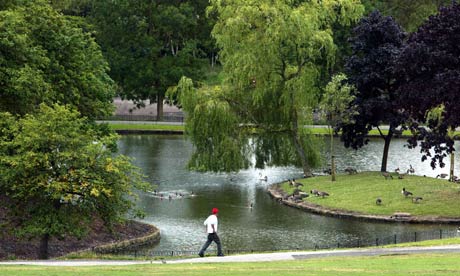
How much is your local park, playing field, allotment or nature reserve worth to you? What price would you put on hearing the rich, varied and flute like song of a blackbird while walking in the countryside? Or the view of a canal or river from your living room window?
According to the government's National Ecosystem Assessment, looking after all the UK's green spaces is worth the sum of £30bn a year to the economy. But to someone who has worked in the environmental movement for more than 20 years – and I expect many of the 5 million people who are members of conservation organisations – they are all priceless.
Putting a monetary value on the natural environment, as the Department for Environment, Food and Rural Affairs (Defra) seeks to do, may fit well with the government's world view that everything has a price but it also smacks of Oscar Wilde's maxim that they know the price of everything and the value of nothing. Treating nature this way will be a disaster for the environment because it means that unscrupulous developers or governments with big deficits can now argue even more vigorously that economic and social gains are worth more than environmental ones. Far from protecting the natural environment it will provide the economic justification for why many more planning applications and major infrastructure projects should go ahead at the expense of our parks, playing fields, allotments and nature reserves.
It also shows that the government seems to have learnt nothing from the debacle of trying to sell off our national forests. Six months ago they valued England's state-owned forests at between just £140m and £250m. However, they soon found out to their cost that many of us thought they were priceless. If over half a million of us signed a petition against selling off our forests, why do they now think that putting a monetary value all our green spaces is something that will win them support?
The whole process becomes even more meaningless when you try to compare the £30bn figure with other economic statistics. Take the UK government's national debt, which at the end of last year was more than £1,105bn or more than 36 times the value credited to our green spaces. That figure has been used to push through the biggest cut in environment spending in generations, including a cut of nearly a third in the budget of Defra. In the case of our green spaces, giving them a monetary value will be used as yet another reason to cut their funding or concrete over what remains of our natural environment. That is because local authorities, planners and governments will always attach a higher economic importance to providing services and building houses or roads than conserving green spaces or wildlife habitats.
Next week the government will launch its much vaunted natural environment white paper. For many environmentalists it will be a chance to establish some environmental credibility after a series of bad decisions and disappointments, from the forestry sell-off to the green investment bank. Central to that will be an understanding that we need to protect the environment because it sustains life on earth and is integral to our wellbeing as a society, not because it's worth a paltry £30bn.

